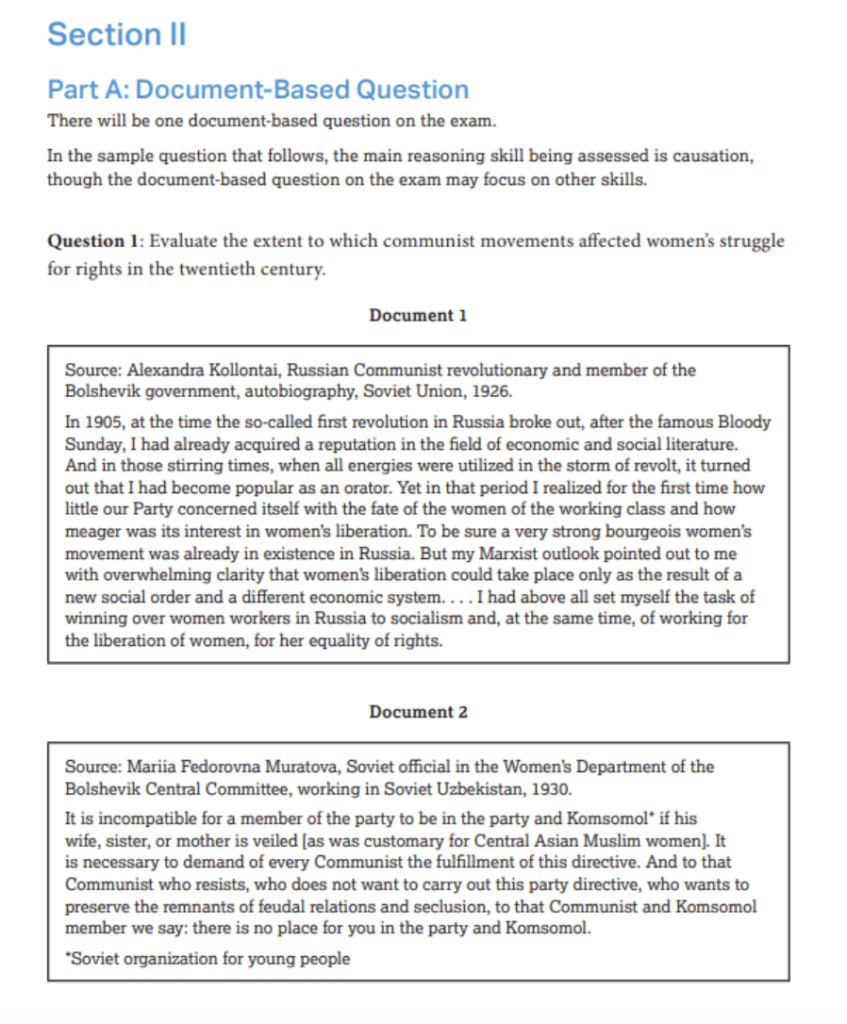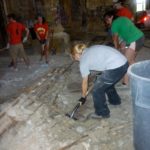10 Hardest AP World History Questions
What’s Covered:
- Overview of the AP World History Exam
- How Will My AP World History Exam Score Impact My College Chances?
- Test Format
- 10 Hardest AP World History Exam Questions
- Final Tips
Overview of the AP World History Exam
The AP World History Exam tests a high school student’s understanding of modern global historical events and processes ranging from c. 1200 CE to the present. Lasting about three hours, it consists of a multiple choice section worth 40% of one’s score and a writing section split up into multiple sub-sections that consists of the other 60%. Like other AP exams, the AP World History Exam is typically offered in May and graded on a 1-5 scale, with 1 representing “No Recommendation” and a 5 appraised as “Extremely well qualified”.
How Will My AP World History Exam Score Impact My College Chances?
Although taking AP courses or the AP Exams are by no means mandatory for college admissions (even at the most selective schools) and AP scores are typically self-reported on the application, your course rigor can have important implications in admissions. Taking the most challenging courses offered at your school, typically AP classes, and earning good grades in them can signal to the admissions officers that you are an academically strong applicant, and can handle a rigorous college curriculum. If you are interested in pursuing a humanities or social science major, a great grade in AP World History, and even a high score on the class’ AP Exam, will likewise signal to the admissions officers that you are well qualified on that path.
Moreover, for prospective college students interested in pursuing history or some type of humanities as a major, achieving a high score on the AP World History Exam can be an important asset. Many universities offer the opportunity to convert a high score (typically a 3 or higher) into credits toward one’s diploma, and a high AP score can also be a prerequisite to enrolling in certain higher level courses in college.
If you’re interested in seeing how your course rigor will affect your chances of acceptance, check out our free chancing engine! This tool will factor in your course rigor, GPA, extracurriculars, demographics, and more to calculate your odds of admission at hundreds of schools across the country. Our chancing engine will even provide tips for how to improve your profile!
Test Format
As a whole, the AP World History Exam is about 3 hours and consists of two main sections: a 55 minute, 55 question multiple choice section worth 40% of a student’s score and a two hour, three-part writing section worth the other 60% of one’s score.
Each part of the writing section will test a student on a different subset of argumentative writing skills, such as defending an argument based on a series of documents and evidence provided by the test booklet. The first part of the writing section consists of 3 Short Answer questions worth 20% of the final score, the second part is a Document-Based Question worth 25% of a student’s score, and the last part includes a Long Essay Question worth 15% of the score. For the digital version of the exam that will be offered later, the scaling is somewhat different, but will mostly feature the same type of content.
10 Hardest AP World History Exam Questions
Multiple Choice Section
For the multiple choice section, the AP test will usually provide some type of historical evidence in the form of a document, map, image, or graph, and will then ask a series of 3-4 questions aimed at deciphering multiple historical aspects of that evidence.
Image Based Questions
The image below from the 2017 AP World History Exam applies to the following three questions.

Due to the rather Eurocentric concentration of many history curriculums, answering questions related to this Ethiopian religious icon may seem intimidating. However, using our knowledge of global historical trends gleaned from studying for the exam, we can hone in on the right answer for each question.
To effectively answer the following questions, it is important to first identify the image (a religious icon of the Madonna and Child, similar to many Catholic and Eastern Orthodox images from the same time period), the time and setting (17th century Ethiopia), and the circumstances behind the work (a commission by a private Ethiopian patron, most likely a wealthy merchant).
Question 1
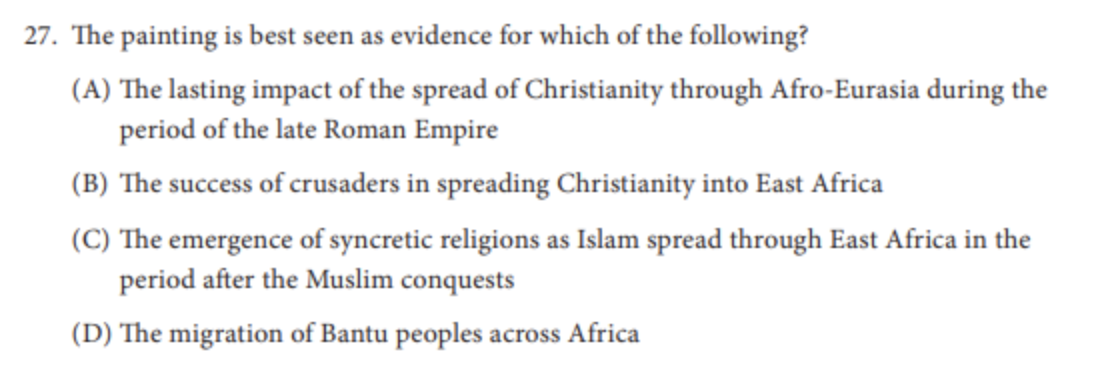
Answer: (A)
This question inquires about the background and historical forces behind the creation of the image. Although one might be tempted to put down B, the correct answer is A. Answer choice B is appealing since the period of the Crusades (around 1200) is closer to the creation of this 17th century painting than the time period of the late Roman Empire (circa 300). However, the answer choice incorrectly places the setting of the Crusades in East Africa, when it actually was fought in the Near East (mostly in the area of present day Israel/Palestine). Consequently, having a solid historical background of various periods and events is important in preventing one from falling for certain “trap” answer choices created by the test makers.
Question 2

Answer: (B)
This question asks the test taker about different historical aspects of the same painting. By reading through the caption provided by the AP test, we see that this religious icon was commissioned by an Ethiopian merchant around the 17th century. From our knowledge of global world history at the time, we know that this period also represented a great expansion in global trade, and the creation of a new commercial class of individuals like ship builders, merchants, and bankers, who took advantage of the new shipping routes criss-crossing the world. With this knowledge, we can identify B as the correct answer. Again, having a strong knowledge of historical trends, and connecting it to the information provided by the test maker is important in honing in on the correct answer.
Question 3
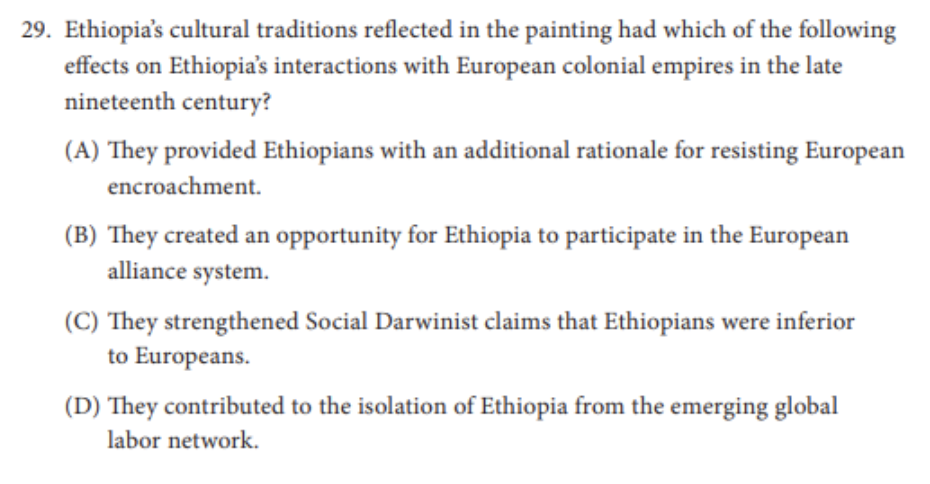
Answer: (B)
This question also relates to different historical aspects of the same painting. Having gone through the AP World History curriculum, we know that the late 19th century represented a “Scramble for Africa” where the great European powers divided up the continent into spheres of influence. We know that Ethiopia was one of the few kingdoms in Africa to avoid becoming a colony of a European power during this era (Italy under Mussolini did eventually subjugate the country during the 1930s despite international outrage). We also know from the information provided by the AP exam and from our answers to the previous questions that this is a religious icon that is representative of the historically Christian nature of Ethiopian society–an aspect that placed the country closer culturally to the European powers than the other mostly Muslim, and pagan religions of other African entities. Thus, piecing together multiple strands of what we know of historical trends, and the information provided by the AP exam, we can safely conjecture the correct answer to be B.
Document Based Questions
In other instances, the test will provide a short written historical document. The following three questions, also from the 2017 exam, refer to the document below.

As before, identify the document (a speech given to the public), the time and setting (mid 19th century India during the British Raj at the height of British Imperialism) and the circumstances of the document (given by a British provincial governor at the opening of a new railway). For written documents, it is also important for the test taker to carefully read the content of the work, and to make careful notes of the author’s tone, and any potential references to historical trends that match the time period of the document’s creation.
We can see that Governor Frere’s speech strikes a very imperialist tone in his claim that the British seem to be modernizing India through developments like the newly developed railway, and are consequently “uplifting” the native Indian populace by supposedly providing them opportunities to advance themselves by laboring in the “modern” British-run economy of 19th century India. Governor Frere’s speech consequently intersects with multiple historical trends of the period (the development of the railway, Age of Imperialism, the Industrial Revolution, etc.).
Having identified multiple aspects of the document, we can now move onto the questions.
Question 1
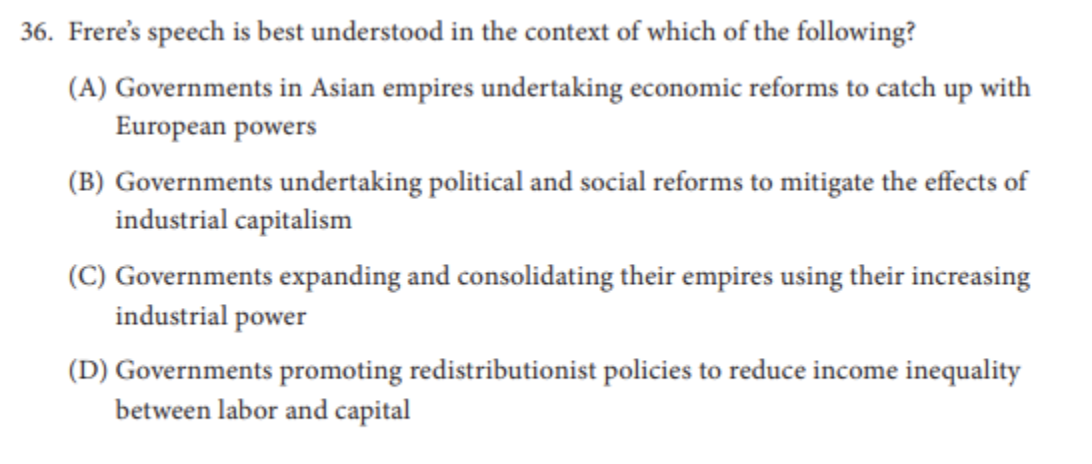
Answer: (C)
Just by extrapolating from the content of the speech, as well as the references to historical trends that are indicative of the time period (industrialization, imperialism, etc.), we know that C best matches what we are looking for.
Question 2

Answer: (B)
We know that the Industrial Revolution greatly shifted global labor markets whereby millions of formerly rural individuals found themselves workers in mostly urban, industrialized enterprises like factories. Again, having a solid knowledge of the historical trends behind the content of the document helps us to identify the B as the correct answer.

[amp-cta id="9459"]
Question 3
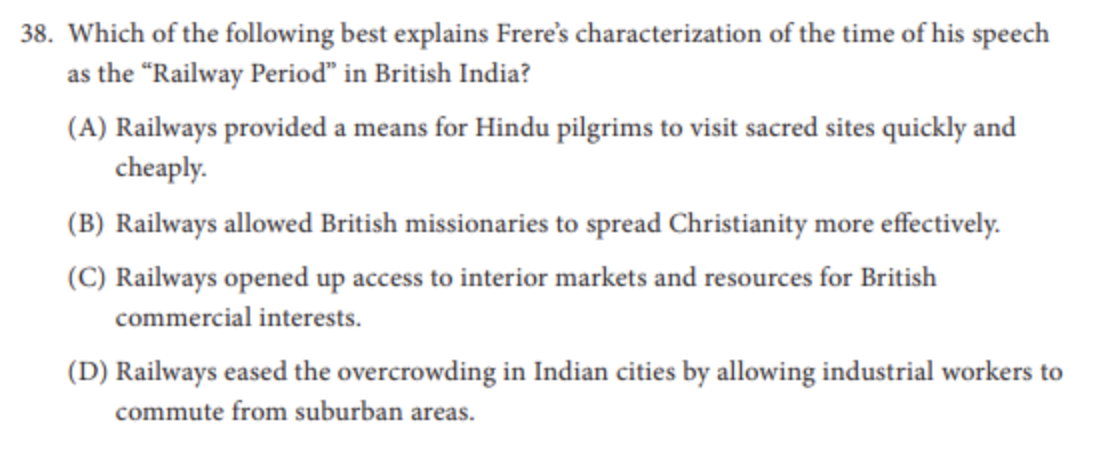
Answer: (C)
The other answer choices are somewhat irrelevant since they are not referenced at all in the content of Frere’s speech. C’s mention of British commercial interests in its colonies lines up especially well with what we know of the historical background of British India at the time.
Question 4
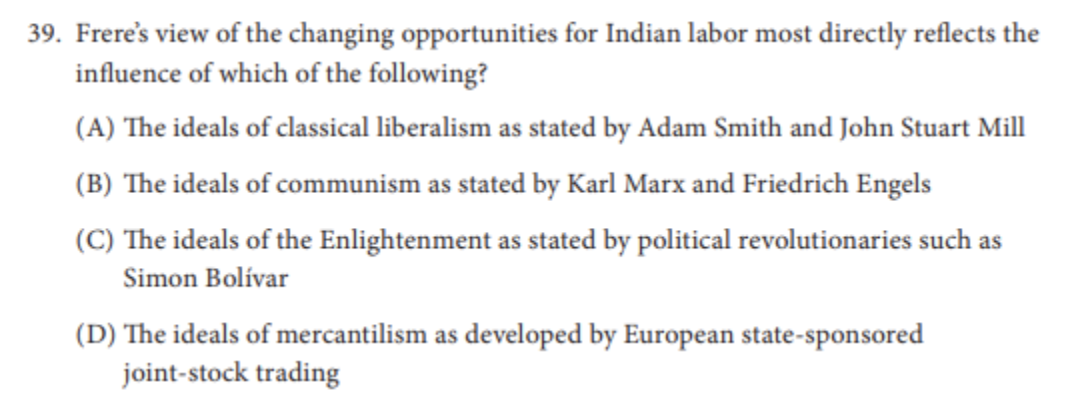
Answer: (A)
The AP World History exam loves to test students on knowledge of historical ideologies and political movements, and this question is a great example. Knowing this, we can rule out B and C since Frere does not once throughout the document reference anything close to communism or the ideals of the Enlightenment. Answer choice D is irrelevant because mercantilism is a term used to describe an economic theory popular in pre-19th century Europe that espoused protectionist trade policies. A is the correct answer since Classical Liberalism refers to a political ideology dominant in the 19th century that focused on uplifting individuals in society through the protection of civil liberties like economic freedoms and property ownership, usually under some form of democratic government.
Writing Section
Moving onto the Writing Section, the Short Answer Questions will similarly ask you to interpret some form of historical evidence. However, this time it is a free response, and you will have to answer a series of questions in paragraph form.
Since these questions are free responses, our example answers might not exactly match what you had in mind, and that’s ok! There are variations of the “correct” answers to each question!
Section I: Short Answer Questions
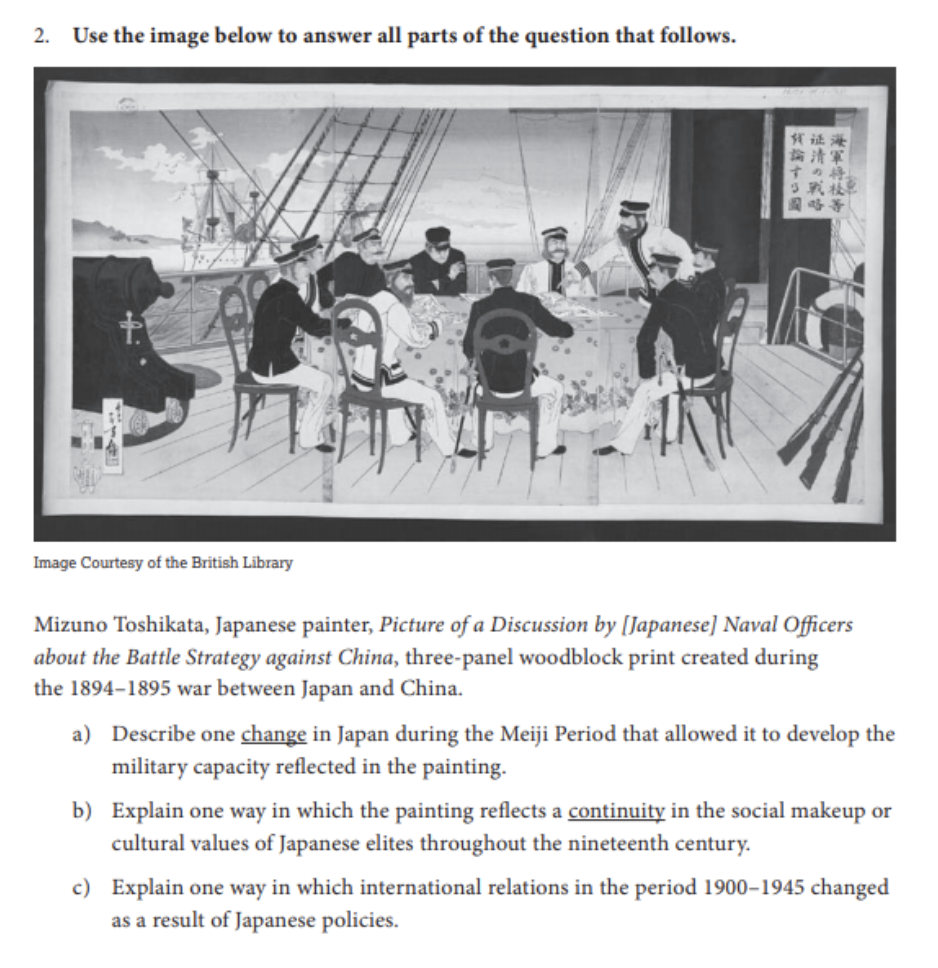
Before jumping into answering the short answer question, it is important that, like in previous questions, we try to understand fully the historical context behind the image. Specifically, this painting dates back to the time of the First Sino-Japanese War (1894-1895) in which a newly industrialized Meiji Japan vanquished Qing China, disrupting the traditionally Sinocentric East Asian political order and claiming Joseon Korea under its sphere of influence. After Tokugawa Japan (1603-1867) famously “opened” itself to Western trade in the mid 19th century, the nation went through a breakneck period of Westernization and industrialization under the leadership of a new progressive minded class of military elites nominally headed by the new Meiji emperor. Knowing this historical context, we can successfully attack this short answer question.
Section II
Section II of the Writing Section includes both the Document-Based (Part A) and Free Response (Part B) Questions.
Part A: Document-Based Question
Now we move on to the Document-Based Question (colloquially known as the “DBQ”). In contrast to the Short Answer Questions, the DBQ will ask you to create a multi-paragraph essay that supports a central thesis using evidence from the 6-7 historical documents that are provided. Generally, the historical evidence provided will all have a similar theme, such as women’s rights in the Communist bloc during the Cold War era.
As a recommendation, before starting your essay, read through all the documents carefully, and make notes on certain trends you can identify, as well as any connections you can make from what you already know about the subject of the DBQ. After spending about 15-20 minutes reading through the documents and making notes, develop your thesis, and start writing. The recommended format is a 5-6 paragraph essay with an introduction paragraph outlining your thesis, 3-4 support paragraphs each with a separate sub-thesis, and a concluding paragraph.
A thesis for this particular DBQ response based on the documents provided could be:
Communist movements in the 20th century contributed to a greater support of women’s rights through the espousing of egalitarian values that ostensibly uplifted women in the Communist bloc from the limitations of past patriarchies. Nonetheless, even this support was limited in its efficacy in advocating for women’s rights, as women in Communist nations continued to face discrimination and hardships based on their gender.
Part B: Free Response Question
Finally, we come to the last part of the Writing Section, the Free Response Question (colloquially known as the “FRQ”).

Like in the DBQ, the FRQ will ask you to create a long form essay that supports a central thesis. Unlike the DBQ, there are no documents provided, so all the supporting evidence you provide will come from memory.
Our recommendation for the FRQ is to pick a question to answer out of the options provided in which you have solid background knowledge. Spend about 10-15 minutes drafting an outline detailing your thesis and supporting evidence, and then proceed to begin writing.
For example, if you possess a strong grasp of world history during the 20th century, then drafting an FRQ response to Question 4 would probably be most suitable.
A sample thesis and supporting evidence to an FRQ response to Question 4 might look like this:
Developments in global trade during the late 20th century transformed the world economy through greater market volatility as a result of increased economic interconnectedness, the reorientation of labor markets in the West, and the rise of transnational economic unions that facilitated the growth of free trade policies.
Sub-thesis (Evidence 1): Developments in global trade during the late 20th century transformed the world economy through greater market volatility:
- 1970s Oil Embargos that contributed to periods of weak growth as entire sectors of Western economies became subject to petroleum shortages as a result of the Arab OPEC’s trade policies against the U.S. in retaliation for its support of Israel.
- 1990s Asian Financial Crisis resulted in multiple countries in East and Southeast Asia facing economic panic as a result of the financial collapse of Thailand’s currency.
- Late 2000s Global Recession that resulted from the U.S. recession triggered by the subprime mortgage crisis.
Sub-thesis (Evidence 2): Developments in global trade during the late 20th century transformed the world economy through the reorientation of labor markets in the West:
- Deindustrialization: Rise of the Rust Belt in the Northeastern and Midwestern U.S. states during the 1960s-1980s; decline of industrial productivity in the traditionally industrialized regions of Northern Britain during the postwar era.
- Growth of service sector industries, and white collar work as the engine of economic productivity in Western nations.
- Greater reliance on immigration in Western nations like the U.S. to fulfill specific labor requirements.
Sub-thesis (Evidence 3): Developments in global trade during the late 20th century transformed the world economy through the rise of transnational regional economic unions that facilitated the growth of free trade:
- Creation of the European Union to facilitate economic cooperation for much of Western Europe by the end of the 20th century.
- Creation of NAFTA in the 1990s between Canada, U.S. and Mexico to encourage trade partnerships in North America.
- ASEAN Free Trade Area to foster cooperation in economic and social development in the Southeast Asia region starting from the 1960s.
Final Tips
On the surface, preparing for the AP World History exam may seem like a herculean undertaking. Scoring well on the test will require months of preparation in the form of reviewing and solidifying your knowledge of the AP World History curriculum.
Create a timeline
Possessing a solid grasp of noteworthy historical events, timelines, terms, and ideologies will help you tackle whatever the AP Exam writers may throw at you on test day. A useful way to consolidate knowledge in preparation for the exam is to create some form of master timeline (handwritten or digital) where you can visualize the important dates, movements, and periods that will most likely be tested on the exam.
Take practice exams
Another useful study method is taking a few timed practice tests from past exam administrations, so that you are prepared mentally for the long three hour marathon of test day. The 2017 AP World History Exam is available for free online through the College Board and other past exams are also available for purchase online.
Check out these CollegeVine resources for more help with your studying:
- Ultimate Guide to the AP World History Exam
- 2021 AP Exam Schedule + Study Tips
- How to Understand and Interpret Your AP Scores
- How Long Is Each AP Exam? A Complete List

